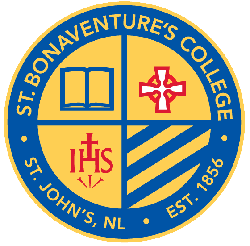Following the consecration of his Cathedral in 1855, Bishop Mullock set about the establishment of a College for the training of future priests and for the preparation of Catholic young men for the professions. For its first President, he selected young Father Enrico Carfagini, O.S.F. who, at the time was lecturing at the Franciscan College in Rome.
While the College building was being erected close to the Cathedral, classes began in the former bishop’s residence on Henry Street on December 1, 1856 with 8 boarders and 32 day students. The College was formally blessed on October 4,1858, at which time Bishop Mullock named it St. Bonaventure’s after the College in Seville, Spain, where he had been educated. To mark the event he presented the school with a painting of its patron, a painting which still adorns the entrance to the College.
For some years, all proceeded smoothly until, in 1863, Father Henry had a falling out with the Bishop and summarily departed from the Island. Bishop Mullock tried to replace him by members of the local clergy, but they were not trained for this work, and the College began to lose both reputation and students.. In 1888, matters came to a head and the College Board decided that it must either close the College or ask the Christian Brothers, who had been running the local boys’ school since 1876, to take over its management.
On Sept 9,1889, the College was reopened under their care. It immediately flourished, numbers of students increased rapidly, and the College soon became the premier school in the Island. When the Rhodes scholarships were instituted in 1904, the College presented the only three eligible candidates, one of whom received the scholarship, thus beginning a long line of distinguished Rhodes Scholars from the College.
By the beginning of the 1900’s, increased enrollment made it necessary to provide more space and the magnificent Mullock Hall was erected. In 1923, an ice rink was built for the use of the students and was instrumental in creating the hockey dynasty for which the College became noted. The steady flow of vocations to the priesthood and religious life gave reality to the dream that had animated Bishop Mullock in commencing it.
In the 1950’s and 1960’s, the influx of students caused by the baby boom necessitated a further expansion, and in 1958, Holland Hall was built on the site of the tennis courts. However, in 1962, the Catholic schools of the city were re-organized and St. Bon’s was reduced to the stature of a grammar school. In 1988, falling vocations caused the Christian Brothers to withdraw from College after administering it admirably for 99 years. The school then came under lay management. In 1992, a dwindling school population caused Mercy College to be amalgamated with St. Bon’s and thus the College became co-educational K-9.
In 1998, the Province voted for the abolition of the denominational system, the schools were again re-organized and St. Bon’s, although still flourishing, became the first Catholic school to be closed in spite of the vehement opposition of the parents.
However, a group of Catholic parents were determined to provide Catholic education for their children. They received the backing of the Jesuit Order, the Society of Jesus, and in September of the following year, 1999, St. Bon’s was re-opened as a separate fee-paying Catholic school with a Jesuit as its President. Each year. has seen the school advance in numbers and reputation. While still under Jesuit auspices, it now has a lay President and a lay Principal with an enrollment of over 360. Academically, it ranks among the highest achievers in the Province. Its music program is the envy of the other schools. It has established a hockey skills program, the only such program in the Province. It has established a substantial bursary program to assist those who cannot pay the full tuition, and it is now searching for more space to accommodate all those who apply for entrance.

